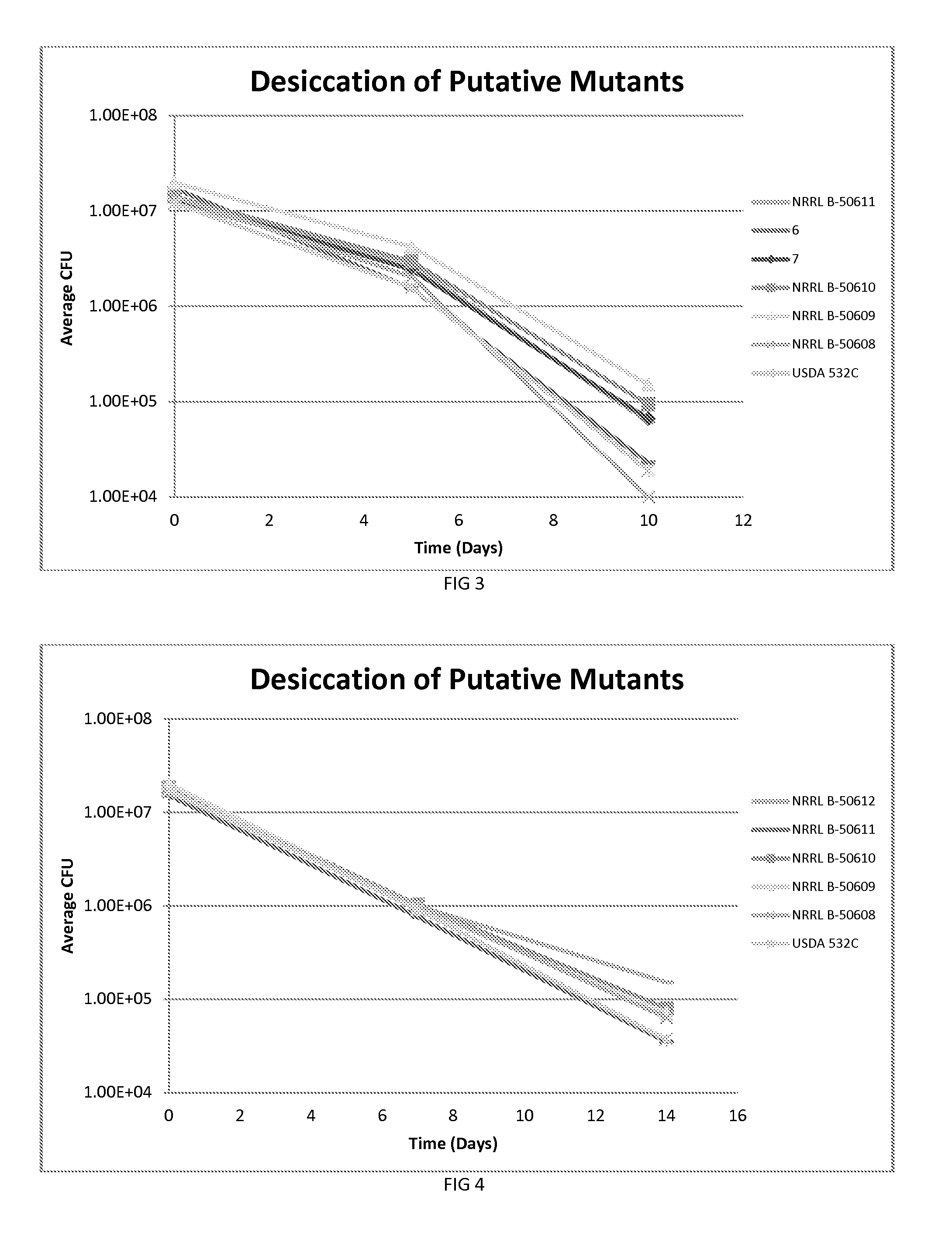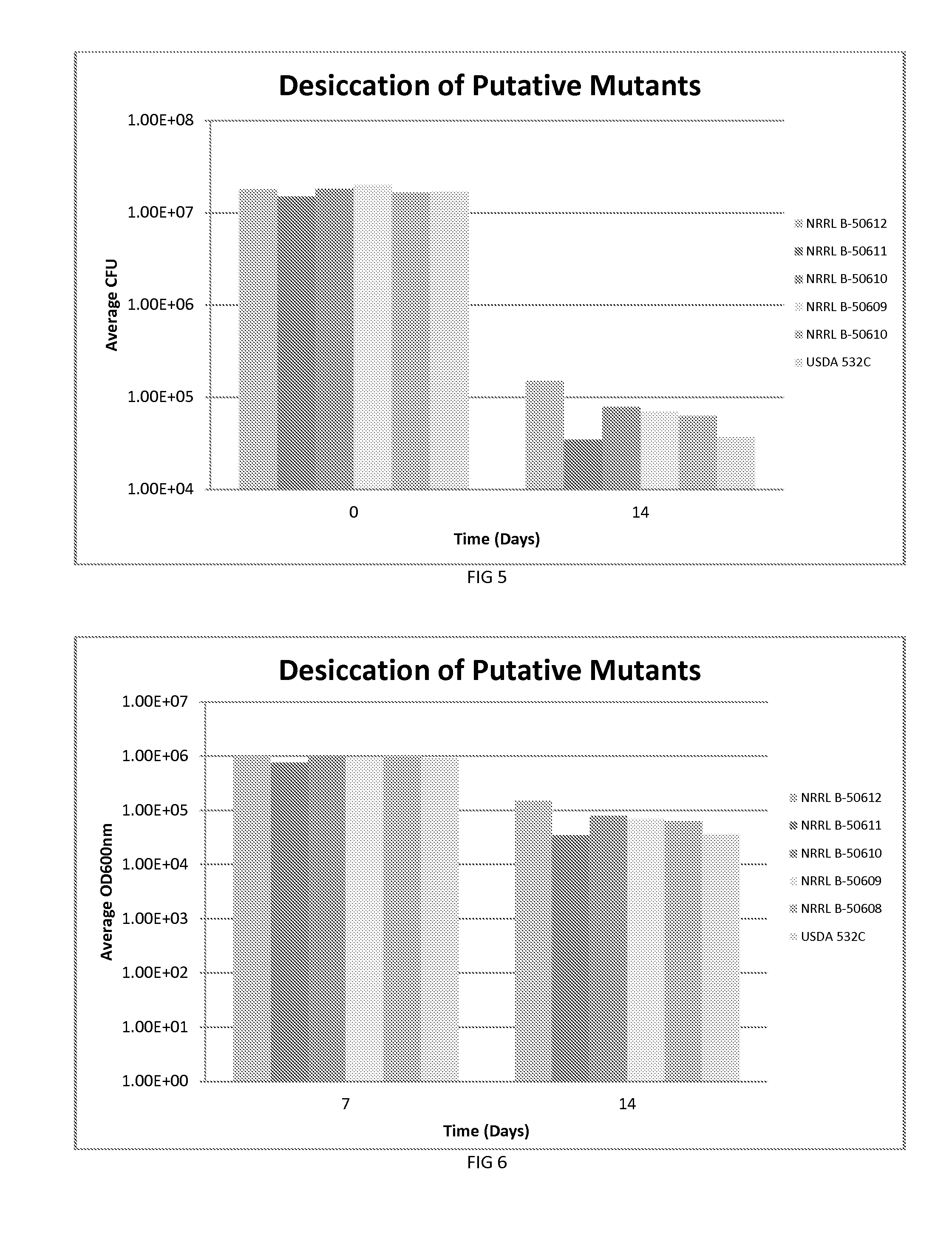Bradyrhizobium strains
a technology of bradyrhizobium and strain, applied in the field of isolated bradyrhizobium bacterium, can solve the problem that essential elements cannot be readily taken up by plants, and achieve the effect of enhancing desiccation resistan
- Summary
- Abstract
- Description
- Claims
- Application Information
AI Technical Summary
Benefits of technology
Problems solved by technology
Method used
Image
Examples
examples
[0206]The following examples are provided for illustrative purposes and are not intended to limit the scope of the invention as claimed herein. Any variations in the exemplified examples which occur to the skilled artisan are intended to fall within the scope of the present invention.
Materials & Methods
Deposit of Biological Material
[0207]The following biological material has been deposited under the terms of the Budapest Treaty at the Microbial Genomics and Bioprocessing Research Unit (NRRL) National Center for Agricultural Utilization Research 1815 N. University Street, Peoria, Ill. 61604, USA and given the following accession number:
TABLE 1Deposit of Biological MaterialIdentificationAccession NumberDate of DepositBradyrhizobia japonicumNRRL B-5061230 Nov. 2011Bradyrhizobia japonicumNRRL B-5061130 Nov. 2011Bradyrhizobia japonicumNRRL B-5061030 Nov. 2011Bradyrhizobia japonicumNRRL B-5060930 Nov. 2011Bradyrhizobia japonicumNRRL B-5060830 Nov. 2011
[0208]The strains have been deposited...
example i
Determine 99.99% Kill Rate for USDA 532C
[0210]The following experiment(s), consisting of three (3) studies, was performed to determine the 99.99% kill rate for parental strain Bradyrhizobia japonicum USDA 532C.
[0211]Parental strain USDA 532C was grown in two 10 ml G16 (Tables 2-4) and YEM (Table 5) disposable culture tubes (VWR, 18×150 mm, #47729-583) for two days and harvested to obtain the highest cell concentration. This was achieved by combining both culture tubes into one tube and concentrating the cells down to 2 ml. Approximately fifty soybean seeds (variety Stine RR 1108-4) were surfaced sterilized in 50 ml sterile, disposable centrifuge tube (Fisher brand, #06-443-18) containing 5% household bleach solution for 30 seconds and rinsed with sterile deionized (DI) water. The sterilization step was repeated for five times. The seeds were immediately placed in a sterilized Petri dish and dried under the laminar hood. Once the seeds were completely dried and transferred to a 250 m...
example ii
Determine the Kill Rate of USDA 532C Using Ethyl Methanesulfonate (EMS)
[0217]The following experiment(s) were performed to determine the application rate of the mutagen, ethyl methanosulfonate (EMS) that would give a 99.9-99.99 percent kill rate for parental strain USDA 532C. This rate determination will become part of the mutagenesis protocol used to generate desiccation-resistant putative mutants although the method of mutagenesis may evolve for efficiency.
[0218]Inocula Preparation:
[0219]Parental strain USDA 532C was grown in six 10 ml YEM disposable culture tubes for two days and 5 ml of the culture was inoculated into four 250 ml flasks containing 50 ml YEM medium. The flasks were incubated for two days at 30° C. shaker. The culture from the flasks were subsequently centrifuged in 50 ml disposable sterile tubes at 8,000 rpm for ten minutes in a Sorvall RC 6 Plus® centrifuge and combined into one tube. The pellet was re-suspended in 4 ml of fresh YEM medium and separated into fou...
PUM
 Login to View More
Login to View More Abstract
Description
Claims
Application Information
 Login to View More
Login to View More - R&D
- Intellectual Property
- Life Sciences
- Materials
- Tech Scout
- Unparalleled Data Quality
- Higher Quality Content
- 60% Fewer Hallucinations
Browse by: Latest US Patents, China's latest patents, Technical Efficacy Thesaurus, Application Domain, Technology Topic, Popular Technical Reports.
© 2025 PatSnap. All rights reserved.Legal|Privacy policy|Modern Slavery Act Transparency Statement|Sitemap|About US| Contact US: help@patsnap.com



